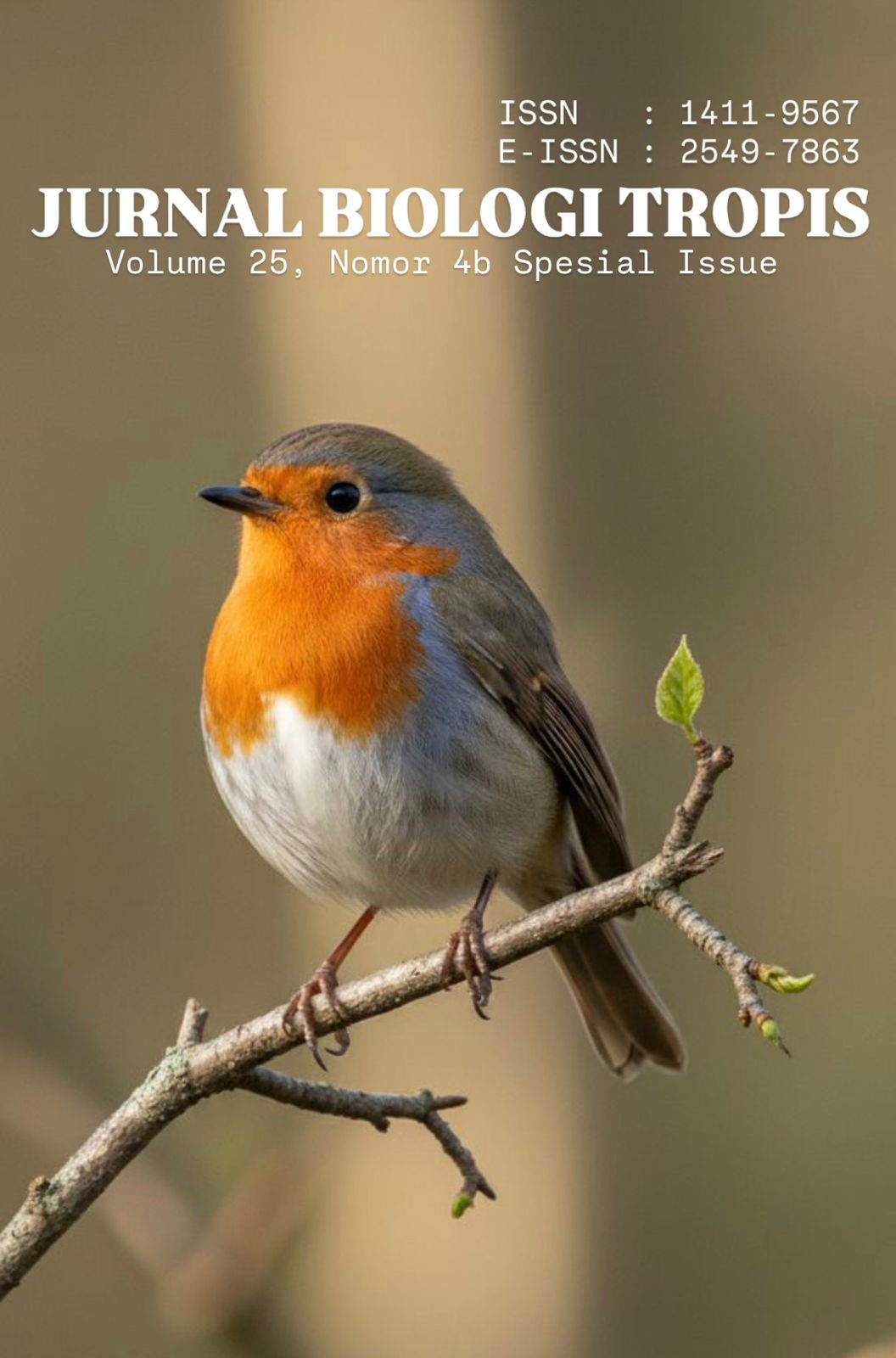A Systematic Literature Review of Environmental Education Strategies in Reducing Aedes sp Populations through Natural Attractant-Based Trapping
Authors
A. Bida Purnamasari , Yuliyanti Setiawati , Erma Suryani SahabuddinDOI:
10.29303/jbt.v25i4b.10704Published:
2025-11-24Issue:
Vol. 25 No. 4b (2025): Special IssueKeywords:
Aedes sp., environmental education, natural attractants, systematic literature review.Articles
Downloads
How to Cite
Downloads
Abstract
Increasing population density in Indonesia, unmanaged urbanization, and climate change have created ideal conditions for the proliferation of Aedes aegypti and Aedes albopictus. Controlling the Aedes sp. mosquito population is not only a health issue, but also a complex ecological and social issue, requiring an integrated strategy involving science, technology, and public education. This study is a Systematic Literature Review (SLR) that aims to examine educational strategies, their roles, and future development directions for Aedes sp. control. The study was conducted following PRISMA guidelines using the Scopus database for the period 2015–2025. A total of 30 articles were identified, 18 of which met the inclusion criteria and were analyzed thematically to identify patterns, effectiveness, and contributions of educational strategies to changes in people's ecological behavior. The results of the study indicate that school-based educational strategies, community training, public campaigns, and citizen science approaches play a significant role in increasing environmental literacy, social participation, and individual and group ecological responsibility. The integration of local culture and sustainable education policies strengthen the program's success by ensuring broader social acceptance. Existing research remains fragmented and has not fully integrated the dimensions of education, ecology, and public health. Therefore, future research is recommended to develop a transdisciplinary approach through collaboration between educational institutions, government, and local communities to create an adaptive, evidence-based, and sustainable vector control system.
References
Aguilar-Durán, J. A., Hamer, G. L., Reyes-Villanueva, F., Fernandez-Santos, N. A., Uriegas-Camargo, S., Rodríguez-Martínez, L. M., Estrada-Franco, J. G., & Rodríguez-Pérez, M. A. (2024). Effectiveness of mass trapping interventions using autocidal gravid ovitraps (AGO) for the control of the dengue vector, Aedes (Stegomyia) aegypti, in Northern Mexico. Parasites and Vectors, 17(1). https://doi.org/10.1186/s13071-024-06361-y
Akhoundi, M., Jourdain, F., Chandre, F., Delaunay, P., & Roiz, D. (2018). Effectiveness of a field trap barrier system for controlling Aedes albopictus: A “removal trapping” strategy. Parasites and Vectors, 11(1). https://doi.org/10.1186/s13071-018-2691-1
Arslan, S. (2012). The Influence of Environment Education on Critical Thinking and Environmental Attitude. Procedia - Social and Behavioral Sciences, 55, 902–909. https://doi.org/10.1016/j.sbspro.2012.09.579
Bansal, S., Lim, J. T., Chong, C.-S., Dickens, B., Ng, Y., Deng, L., Lee, C., Tan, L. Y., Kakani, E. G., Yoong, Y., Du Yu, D., Chain, G., Ma, P., Sim, S., Ng, L. C., & Tan, C. H. (2024). Effectiveness of Wolbachia-mediated sterility coupled with sterile insect technique to suppress adult Aedes aegypti populations in Singapore: a synthetic control study. The Lancet Planetary Health, 8(9), e617–e628. https://doi.org/10.1016/S2542-5196(24)00169-4
Boerlijst, S. P., Trimbos, K. B., van der Beek, J. G., Dijkstra, K. B., van der Hoorn, B. B., & Schrama, M. (2019). Field evaluation of DNA based biodiversity monitoring of Caribbean mosquitoes. Frontiers in Ecology and Evolution, 7(JUL). https://doi.org/10.3389/fevo.2019.00240
Chanampa, M., Gil, J. F., Aparicio, J. P., Castillo, P., Mangudo, C., Copa, G. N., & Gleiser, R. M. (2018). Field comparison of oviposition substrates used in ovitraps for Aedes aegypti surveillance in Salta, Argentina. Journal of Applied Entomology, 142(10), 985–990. https://doi.org/10.1111/jen.12554
Chen, J., Huo, X., Wilke, A. B. B., Beier, J. C., Vasquez, C., Petrie, W., Cantrell, R. S., Cosner, C., & Ruan, S. (2023). Linking mathematical models and trap data to infer the proliferation, abundance, and control of Aedes aegypti. Acta Tropica, 239. https://doi.org/10.1016/j.actatropica.2023.106837
Echaubard, P., Thy, C., Sokha, S., Srun, S., Nieto-Sánchez, C., Peeters-Grietens, K. P., Juban, N. R., Mier-Alpano, J., Deacosta, S., Sami, M., Braack, L., Ramirez, B., & Hii, J. (2020). Fostering social innovation and building adaptive capacity for dengue control in Cambodia: A case study. Infectious Diseases of Poverty, 9(1). https://doi.org/10.1186/s40249-020-00734-y
Eduardo Eiras, A. E., Costa, L. H., Batista-Pereira, L. G., Paixao, K. S., & Batista, E. P. A. (2021). Semi-field assessment of the Gravid Aedes Trap (GAT) with the aim of controlling Aedes (Stegomyia) aegypti populations. PLOS ONE, 16(4 April). https://doi.org/10.1371/journal.pone.0250893
Grimshaw, J. M., Hróbjartsson, A., Lalu, M. M., Li, T., Loder, E. W., Mayo-Wilson, E., McGuinness, L., McDonald, S., Stewart, L. A., Thomas, J., Tricco, A. C., Welch, V. A., Whiting, P., Moher, D., Glanville, J., Chou, R., Brennan, S. E., Boutron, I., Akl, E., … Tetzlaff, J. M. (2021). The PRISMA 2020 statement: an updated guideline for reporting systematic reviews. Medicina Fluminensis, 57(4), 444–465. https://doi.org/10.21860/medflum2021_264903
Guo, X., Zhou, S., Wu, J., Zhang, X., Wang, Y., Li, Z., Chen, X.-G., & Zhou, X. (2022). An Experimental Evaluation of Toxicity Effects of Sodium Chloride on Oviposition, Hatching and Larval Development of Aedes albopictus. Pathogens, 11(2). https://doi.org/10.3390/pathogens11020262
Guo, Y., Yang, S., Boonyamalik, P., Powwattana, A., Zhu, W., & Xu, L. (2024). Development of a social learning theory-based pressure injury training program for nursing assistants in Chinese nursing homes. Frontiers in Public Health, 12. https://doi.org/10.3389/fpubh.2024.1478147
Hardianto, H., Mahanal, S., Susanto, H., & Prabaningtyas, S. (2024). Protist literacy: A novel concept of protist learning in higher education. Eurasia Journal of Mathematics, Science and Technology Education, 20(2), em2399. https://doi.org/10.29333/ejmste/14157
Holeva-Eklund, W. M., Young, S. J., Will, J., Busser, N., Townsend, J., & Hepp, C. M. (2022). Species distribution modeling of Aedes aegypti in Maricopa County, Arizona from 2014 to 2020. Frontiers in Environmental Science, 10. https://doi.org/10.3389/fenvs.2022.1001190
Johnson, M. F. (2014). Network environmentalism: Citizen scientists as agents for environmental advocacy. Global Environmental Change, 29, 235–245. https://doi.org/10.1016/j.gloenvcha.2014.10.006
Kaya, E. (2013). Teaching the subject of ecology through jigsaw cooperative learning in a biology laboratory. Energy Education Science and Technology Part B: Social and Educational Studies, 5(1), 663–676. https://api.elsevier.com/content/abstract/scopus_id/84869751806
Knapp, J. A., Waits, C. M., Briley, A. K. C., Cilek, J. E., Richardson, A. G., & Pruszynski, C. (2018). Application Efficacy of Vectobac WDG Against Larval Aedes aegypti Using Thermal Fog Technology. Journal of the American Mosquito Control Association, 34(1), 75–77. https://doi.org/10.2987/17-6705.1
Kozyreva, A. (2020). Citizens Versus the Internet: Confronting Digital Challenges With Cognitive Tools. Psychological Science in the Public Interest, 21(3), 103–156. https://doi.org/10.1177/1529100620946707
Liu, Q. (2019). Effects of environmental education on environmental ethics and literacy based on virtual reality technology. Electronic Library, 37(5), 860–877. https://doi.org/10.1108/EL-12-2018-0250
Loring, P. A. (2016). Toward a Theory of Coexistence in Shared Social-Ecological Systems: The Case of Cook Inlet Salmon Fisheries. Human Ecology, 44(2), 153–165. https://doi.org/10.1007/s10745-016-9806-0
Muharni, A., Mahanal, S., Zubaidah, S., Susanto, H., & Hardianto, H. (2025). Developing and validating the ACCA (Activation-Collaboration-Creation-Application) learning model to enhance students’ collaboration. Research and Development in Education (RaDEn), 5(1), 605–618. https://doi.org/10.22219/raden.v5i1.40024
Muhdhar, M. H. I. A., Aini, N., Rohman, F., Sumberartha, I. W., Mardiyanti, L., & Wardhani, W. (2021). Improvement of collaboration skills and environmental literacy through the surrounding nature exploration integrated group investigation. In H. Suwono, H. Habiddin, & D. Rodic (Eds.), AIP Conference Proceedings (Vol. 2330). American Institute of Physics Inc. https://doi.org/10.1063/5.0043101
Nurwidodo, N., Amin, M., Ibrohim, I., & Sueb, S. (2020). The role of eco-school program (Adiwiyata) towards environmental literacy of high school students. European Journal of Educational Research, 9(3), 1089–1103. https://doi.org/10.12973/EU-JER.9.3.1089
Owusu-Asenso, C. M., Mingle, J. A. A., Weetman, D., & Afrane, Y. A. (2022). Spatiotemporal distribution and insecticide resistance status of Aedes aegypti in Ghana. Parasites and Vectors, 15(1). https://doi.org/10.1186/s13071-022-05179-w
Paiz-Moscoso, K. E., Cisneros-Vázquez, L. A., Danis-Lozano, R., Rodríguez-Rojas, J. J., Rebollar-Téllez, E. A., Sánchez-Casas, R. M., & Fernández-Salas, I. (2023). Design and Evaluation of a Sticky Attractant Trap for Intra-Domiciliary Surveillance of Aedes aegypti Populations in Mexico. Insects, 14(12). https://doi.org/10.3390/insects14120940
Poulin, B., Lefebvre, G., Muranyi-Kovacs, C., & Hilaire, S. (2017). Mosquito traps: An innovative, environmentally friendly technique to control mosquitoes. International Journal of Environmental Research and Public Health, 14(3). https://doi.org/10.3390/ijerph14030313
Ridha, M. R., Marlinae, L., Zubaidah, T., Fadillah, N. A., Widjaja, J., Rosadi, D., Rahayu, N., Ningsih, M., Desimal, I., & Sofyandi, A. (2023). Control methods for invasive mosquitoes of Aedes aegypti and Aedes albopictus (Diptera: Culicidae) in Indonesia. Veterinary World, 16(9), 1952–1963. https://doi.org/10.14202/vetworld.2023.1952-1963
Sager, F. (2013). Sorting through the garbage can: Under what conditions do governments adopt policy programs? Policy Sciences, 46(1), 1–21. https://doi.org/10.1007/s11077-012-9165-7
Shannon, C., Lovrien, P. D., Barnett, B., Steinlicht, C., & Koromyslova, E. (2022). Multidisciplinary Capstone Design Experiences: Students’ Perspective. ASEE Annual Conference and Exposition, Conference Proceedings. https://www.scopus.com/inward/record.uri?eid=2-s2.0-85138316010&partnerID=40&md5=575fff91afa26aa16b53faf4fd45b309
Sissoko, F., Junnila, A., Traoré, M. M., Traoré, S. F., Doumbia, S., Dembélé, S. M., Schlein, Y., Traoré, A. S., Petrányi, P., Xue, R.-D., Arheart, K. L., Revay, E. E., Kravchenko, V. D., Beier, J. C., & Müller, G. C. (2019). Frequent sugar feeding behavior by Aedes aegypti in Bamako, Mali makes them ideal candidates for control with attractive toxic sugar baits (ATSB). PLOS ONE, 14(6). https://doi.org/10.1371/journal.pone.0214170
Sulisetijono, S., Wulandari, I. A. I., Astuti, L., Muhdhar, M. H. I. A., Abdillah, R. R., Wardhani, Y. S., Zahro, S. M., & Achmad, R. (2024). The effectiveness of the Adiwiyata electronic module based on multi-model in improving technological literacy, collaboration skills and environmental literacy. In H. Habiddin & T. Ronceviv (Eds.), AIP Conference Proceedings (Vol. 3106, Issue 1). American Institute of Physics. https://doi.org/10.1063/5.0215551
Sun, H., Jit, M., Cook, A. R., Carrasco, L. R., & Dickens, B. (2018). Determining environmental and anthropogenic factors which explain the global distribution of aedes aegypti and Ae. Albopictus. BMJ Global Health, 3(4). https://doi.org/10.1136/bmjgh-2018-000801
van de Vossenberg, B. T. L. H., Ibáñez-Justicia, A., Metz-Verschure, E., van Veen, E. J., Bruil-Dieters, M. L., & Scholte, E. J. (2015). Real-time PCR tests in Dutch exotic mosquito surveys; Implementation of Aedes aegypti and Aedes albopictus identification tests, and the development of tests for the identification of Aedes atropalpus and Aedes japonicus japonicus (diptera: Culicidae). Journal of Medical Entomology, 52(3), 336–350. https://doi.org/10.1093/jme/tjv020
Widyanto, A., Unggul Satoto, T. B., & Kusmintarsih, E. S. (2023). Effectiveness of indoor and outdoor larvitrap modified jars and paralon hit for Aedes spp. Control. Journal of Public Health in Africa, 14(S2). https://doi.org/10.4081/jphia.2023.2613
Wilke, A. B. B., Vasquez, C., Carvajal, A., Ramirez, M., Cardenas, G., Petrie, W., & Beier, J. C. (2021). Effectiveness of adulticide and larvicide in controlling high densities of Aedes aegypti in urban environments. PLOS ONE, 16(1 1). https://doi.org/10.1371/journal.pone.0246046
Yalwala, S., Clark, J., Oullo, D., Ngonga, D., Abuom, D., Wanja, E., & Bast, J. (2015). Comparative efficacy of existing surveillance tools for Aedes aegypti in Western Kenya. Journal of Vector Ecology, 40(2), 301–307. https://doi.org/10.1111/jvec.12168
License
Copyright (c) 2025 A. Bida Purnamasari, Yuliyanti Setiawati, Erma Sahabuddin

This work is licensed under a Creative Commons Attribution 4.0 International License.

Jurnal Biologi Tropis is licensed under a Creative Commons Attribution 4.0 International License.
The copyright of the received article shall be assigned to the author as the owner of the paper. The intended copyright includes the right to publish the article in various forms (including reprints). The journal maintains the publishing rights to the published articles.
Authors are permitted to disseminate published articles by sharing the link/DOI of the article at the journal. Authors are allowed to use their articles for any legal purposes deemed necessary without written permission from the journal with an acknowledgment of initial publication to this journal.


























